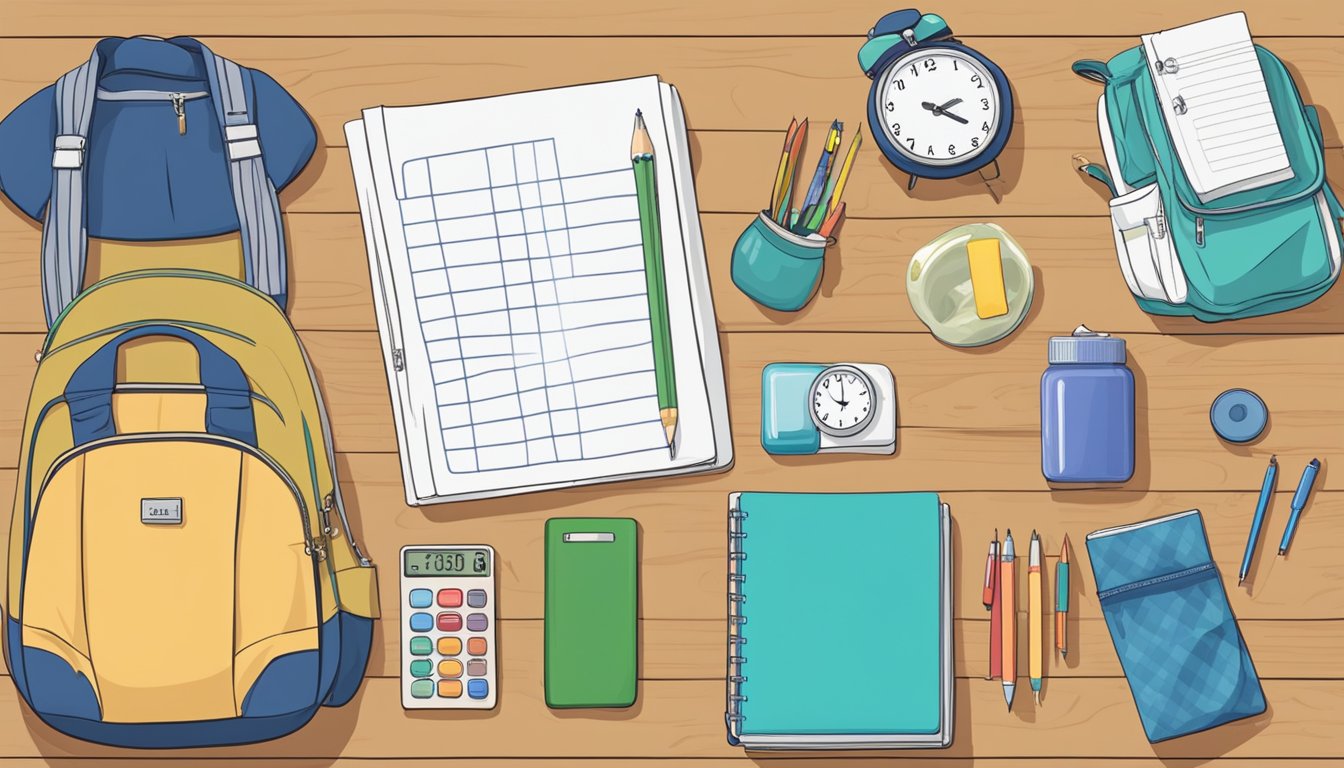Prepare the Night Before

One of the most effective ways to simplify our kids’ morning routines is by preparing as much as possible the night before. By taking care of key tasks before bedtime, we can ensure a smoother, more predictable morning for both ourselves and our children.
I find it helpful to create a bedtime routine that includes activities such as laying out clothes for the next day, packing lunches, and organizing backpacks. This not only reduces the number of tasks that need to be done in the morning but also teaches our kids the importance of planning and responsibility. Adding consistency to our nightly routine increases predictability for our children, helping them feel more secure.
Checklists and charts are useful tools for both parents and kids to keep track of our evening tasks. We can use a simple table like this to list out tasks and responsibilities:
| Task | Parent Responsibility | Child Responsibility |
|---|---|---|
| Choose and lay out clothes | Assistance if needed | Main responsibility |
| Pack lunch | Main responsibility | Assistance if needed |
| Load backpack with essentials | Support and guidance | Main responsibility |
By breaking down the tasks in this way, we can ensure that both parents and children are clear about their responsibilities and that nothing gets overlooked. Encourage our kids to tick off each task on the checklist once it’s completed, helping to develop a sense of accomplishment and encouraging good habits.
As parents, we can also set a good example for our children by preparing for our mornings in a similar way. When our kids see us taking care of our clothes and work essentials the night before, they’ll be more likely to adopt these habits themselves.
Incorporating planning and preparation into our evenings can help ease some of the stresses of the morning rush, allowing us to start our days with a calmer, more focused mindset. By involving our kids in the process, we teach them valuable life skills and create a more harmonious environment for the whole family.
Establish a Consistent Wake-Up Time

A key aspect of simplifying morning routines for kids is to establish a consistent wake-up time. By waking up at the same time every day, children can align their circadian rhythm, which helps regulate a consistent sleep pattern. This makes it easier for them to rise in the morning and feel more refreshed throughout the day.
To begin this process, I suggest creating a family wake-up time. This time should be appropriate for everyone’s needs, and it should allow enough time for daily responsibilities and routines to be completed. Parents should be patient, especially during the first few days, as children may take some time to adjust to a new schedule.
To further optimize the morning routine, consider these tips:
- Prepare the night before: Encourage children to pack their school bags and choose their clothes the evening before. This can reduce morning stress and save time.
- Create a morning checklist: Make a list of daily tasks, such as brushing teeth, getting dressed, and eating breakfast. This helps children learn responsibility and accountability for their morning routine.
- Be patient: Adjusting to a new routine takes time, so it’s important to be patient with your child during this process. Providing gentle reminders and showing support can make the transition smoother.
Consistency is key in maintaining a well-regulated circadian rhythm. The more consistent a child’s wake-up time is, the easier it will be for them to naturally wake up at the chosen time without feeling groggy. Additionally, having the whole family on the same schedule promotes cooperation and unity in tackling the day ahead.
Keep in mind, as with any change, it may take some time for your child to adapt to a new wake-up schedule. With dedication, patience, and a clear understanding of the importance of a consistent wake-up time, mornings can become a simpler and more enjoyable experience for the whole family.
Create a Morning Routine Chart

One of the best ways to simplify morning routines for kids is to create a morning routine chart. This visual aid will help your children know what tasks they need to complete every morning, giving them a sense of direction and responsibility.
To make the chart, grab a poster board or a whiteboard and divide it into sections for each of your children. In each section, list the morning tasks, such as:
- Wake up: Set an alarm clock or encourage your kids to wake up at a specific time.
- Make the bed: Teach them to fix their beds right after waking up.
- Brush teeth: Emphasize the importance of oral hygiene.
- Get dressed: Encourage them to choose their clothes the night before to save time.
- Eat breakfast: Plan out breakfast menus in advance to streamline the process.
- Pack lunch: Have your kids help in preparing their lunches the night before.
- Gather belongings: Develop a habit of placing school bags, shoes, and jackets in a designated area.
Using colors, stickers, or doodles can make the chart visually appealing for younger children. Additionally, you can use a table format if you prefer a more organized look:
| Task | Child 1 | Child 2 | Child 3 |
|---|---|---|---|
| Wake up | X | X | X |
| Make the bed | X | X | X |
| Brush teeth | X | X | X |
| Get dressed | X | X | X |
| Eat breakfast | X | X | X |
| Pack lunch | X | X | X |
| Gather belongings | X | X | X |
For an even smoother morning, I recommend setting up a reward system to motivate your children. You can use stickers, tokens, or points to track their progress, and once they reach a certain amount, treat them with a small reward.
Incorporating a morning routine chart in your family’s daily life not only teaches your children valuable time-management skills but also promotes a sense of independence. Give it a try and see how it transforms your mornings!
Simplify Breakfast Choices

I’ve found that one of the main challenges in creating an efficient morning routine is deciding what to have for breakfast. To address this issue, I’ve narrowed down my kids’ options to a few healthy breakfast choices they can easily pick from.
For weekday mornings, we stick to three simple, nutrient-rich options: whole-grain cereal with milk and fruit, yogurt with fruit and nuts, or toast with peanut butter and banana. By having a limited selection of easy-to-make meals, the decision-making process is sped up, leaving more time for other important morning tasks.
When it comes to beverages, coffee isn’t a suitable option for children. Instead, I provide them with healthier alternatives such as water, milk, or orange juice to keep them hydrated and ensure they get essential nutrients.
Here’s a table summarizing our go-to breakfast options:
| Breakfast Option | Main Ingredients | Nutrients |
|---|---|---|
| Whole-grain Cereal | Cereal, milk, fruit | Fiber, protein, vitamins |
| Yogurt Parfait | Yogurt, fruit, nuts | Protein, vitamins, healthy fats |
| Peanut Butter Toast | Toast, peanut butter, banana | Protein, carbohydrates, potassium |
To make things even more efficient, I prepare and chop fruits or other ingredients the night before, or even batch-make certain items, like homemade granola, over the weekend. This way, breakfast assembly during the weekday mornings becomes a breeze.
It’s okay to occasionally switch up the options on weekends or special occasions, but maintaining a consistent, simple selection of meals on busy mornings not only simplifies the routine but also reinforces healthy eating habits. With these easy and nutritious breakfast ideas, I’ve noticed that my kids are more focused and energized throughout their day.
Delegate Responsibilities

Delegating responsibilities is a powerful way to develop independence and confidence in our children, as well as a smoother morning routine. As a parent, it’s crucial to shift some everyday tasks to our kids, empowering them to take charge of their mornings.
One of the best methods to delegate tasks is by creating a simple checklist. This helps break down their responsibilities into manageable activities while providing a sense of accomplishment. Use tables or bullet points to structure the checklist:
- Personal Care: brushing teeth, washing face, getting dressed
- Meal Preparation: setting the table, making breakfast, packing lunch
- Organizing: preparing backpack, gathering extracurricular items, tidying up personal space
Taking responsibility for their tasks fosters independence and allows me to focus on my own morning routine. To further enhance efficiency, consider implementing a visual schedule that includes:
- Task
- Time allotted for the task
- Order of tasks
Having a constant visual reminder helps them stay on track and ensures consistency in our morning routines.
Furthermore, providing choices within delegated tasks can bolster their confidence and make the morning process more enjoyable. For example, let them pick their outfit or breakfast, reinforcing their decision-making skills.
Remember that patience is crucial during this period as children adapt to their new responsibilities. Offering encouragement, praise, and guidance will bolster their motivation and foster a sense of pride in their capabilities.
By delegating responsibilities, we create a more streamlined morning routine while nurturing our children’s confidence, independence, and skills essential for their personal growth.
Limit Morning Screen Time
As a parent, I’ve found that limiting morning screen time is crucial for simplifying morning routines for kids. Allowing children to watch TV, play video games, or use their devices in the morning can make it challenging for them to focus on getting ready for the day. To avoid potential issues, it’s essential to set boundaries and reduce screen time in the mornings.
One strategy I’ve used is to clearly communicate the consequences of excessive screen time in the morning. Explain to your kids that spending too much time on screens before school can make it difficult for them to concentrate during the day, leading to poor academic performance and other negative consequences.
As recommended by a family therapist, I’ve found it helpful to create a morning routine schedule that includes specific tasks and activities to complete before screens can be used. Be sure to be consistent and stick to this schedule as much as possible. Here’s an example of a morning routine schedule:
- Wake up
- Get dressed
- Brush teeth
- Eat breakfast
- Pack lunch
- Gather school supplies
- Only then, can screens be used if time permits.
Another tip is to engage your child’s emotions during the morning by having them participate in non-screen activities that are fun and engaging. These can include talking, playing with toys, or engaging in creative activities like drawing or coloring. This will help create a positive environment in the morning and reduce the reliance on screens.
In summary, limiting morning screen time can significantly benefit children’s focus and overall well-being. By setting clear boundaries, involving your kids in developing the morning routine, and providing non-screen alternatives, you can create a more simplified and efficient morning routine.
Organize Bathroom Time
From my experience, organizing bathroom time is crucial for simplifying morning routines. Doing so requires time management, patience, and punctuality. As a parent, I have found that these three steps can help in making bathroom activities faster and more efficient:
- Create a schedule To manage everyone’s time efficiently and ensure that mornings run smoothly, I start by creating a schedule that allocates time slots for each child’s bathroom activities. This helps in avoiding arguments over who gets in the bathroom first and allows them to be more punctual.
- Prepare the night before I always encourage my kids to set out their clothes, towels, and toiletries the night before. This not only saves time in the morning but also teaches them about time management and preparation. As a result, my children have learned patience, which has helped them in their daily lives.
- Teach independence Getting dressed should be a task that children can independently accomplish. I usually teach them how to dress themselves as early as possible, so they can effectively manage their time. Also, I remind them to keep their clothes organized, which can help significantly reduce the time spent searching for particular items.
By following these strategies, I have been able to maintain an organized bathroom routine for my kids. Establishing these habits early on not only makes mornings easier for everyone, but also contributes to the development of essential life skills.
Have a Designated Drop Zone
As a parent, I’ve found that having a designated drop zone is a game changer in simplifying morning routines for my kids. A drop zone is a designated area where your kids can drop off their backpacks, shoes, and other belongings when they get home from school. This creates a sense of organization and helps keep your home tidy.
To set up a successful drop zone, choose a spot close to the entrance your family uses most often. This could be the front door, garage, or even the mudroom. Then, create a designated space for each child’s belongings. I recommend using hooks for backpacks, shelves for shoes, and containers for smaller accessories like hats and gloves. You can also label each spot with your child’s name for added personalization.
Organized Drop Zone Checklist
- Convenient location next to entrance
- Hooks for backpacks
- Shelves for shoes
- Containers for accessories
- Labels with names
By teaching my kids the importance of putting away their belongings in their designated drop zone, they’ve learned the concept of responsibility. This also keeps our home organized and prevents the morning rush of looking for misplaced items. As part of their evening routine, my kids know that they need to have their backpacks ready and placed in the drop zone, so they’re prepared for the next day.
In addition to the physical organization, having a designated drop zone improves family communication. I no longer have to ask my kids where they left their backpacks or if they’ve finished their homework. Instead, I can easily glance at the drop zone and know that they’re prepared for the next day.
Implementing a designated drop zone into your home not only simplifies morning routines, but it also encourages responsibility and organization in your kids’ daily lives. It may take a bit of effort to set up initially, but the benefits are well worth it.
Use Timers and Alarms
I’ve found that incorporating timers and alarms into our morning routine greatly helps with time management and punctuality. This not only ensures that the whole family is on track, but it also helps children build confidence in their ability to manage their own time.
One way I use timers is by setting a specific amount of time for each task in the routine. For example, my family’s morning routine consists of the following steps:
- Wake up – alarm set at 7:00 AM
- Get dressed – 10 minutes
- Brush teeth – 3 minutes
- Eat breakfast – 15 minutes
- Pack bags – 5 minutes
By allotting a certain duration for each task, it helps ensure that everyone is moving at an appropriate pace. Additionally, using a visual timer can be beneficial, especially for younger children, as they can see the time going down and know how much time they have left for the task.
Setting up alarm clocks or using smartphone alarms for wake-up times is a simple yet effective way to start the morning. I have noticed that having a specific alarm sound that signals it’s time to wake up helps my family wake up more efficiently and with less resistance.
Another useful method is setting up “checkpoints” throughout the morning routine. For instance, a checkpoint can be set halfway through the getting ready process to make sure everyone is on track. If someone is lagging behind, this serves as a reminder to speed up and stay on track.
Utilizing timers and alarms in our morning routines not only improves punctuality for the whole family but also builds confidence in children. By following a well-structured routine, children learn how to manage their time effectively and become more independent. As a result, they can carry these time management skills into other aspects of their lives, such as school and extracurricular activities.
Build in Extra Time
Building extra time into your morning routine is essential for minimizing stress and chaos. As a parent, I understand how much easier mornings become when I allocate a buffer for the inevitable delays. Here are a few tips on how you can build extra time into your family’s morning routine.
First and foremost, wake up earlier than your children. Having some alone time allows you to focus on your needs, such as meditation, exercise, or even enjoying a cup of coffee in peace. This additional time helps me feel more prepared and calm, which in turn sets a positive tone for the entire family.
Another crucial aspect is to set realistic expectations. Understand that your children may need more time to complete tasks, and that’s okay. For example, a table with approximate times for breakfast, getting dressed, brushing teeth, etc., can be useful in estimating the time required:
| Task | Time (minutes) |
|---|---|
| Breakfast | 20 |
| Getting dressed | 15 |
| Brushing teeth | 5 |
| Packing bags | 10 |
| Total time | 50 |
Now, add an extra 10-15 minutes to the total time as a buffer for any unexpected delays.
Having a clear communication system is essential in time management. Encourage your children to express any concerns or needs related to the morning routine. Open communication with my kids ensures that everyone is aware of the schedule and can work together.
Incorporating simple organization methods also makes a significant difference in saving time. For instance, laying out clothes the night before, keeping backpacks and shoes in designated spots, or prepping lunches helps reduce wasted time searching for items in the morning.
Lastly, I cannot stress enough the importance of patience and flexibility. Mornings can be unpredictable, and it’s essential to approach them with a positive attitude and adapt when necessary. Staying calm and collected maintains a pleasant atmosphere, even when things don’t go as planned.
By implementing these strategies, you can build extra time into your morning routine, fostering a smoother and more enjoyable start to the day.
Review and Adjust the Routine Regularly
As a parent, I understand the importance of a consistent morning routine for kids. However, it’s crucial to remain adaptable and recognize that our family’s needs change over time. After a few weeks or when significant life events occur, I recommend sitting down and assessing the morning routines to ensure they still serve our family effectively.
When revamping the routine, I consider the following:
- Flexibility: Are there any aspects of the routine that are too rigid or inflexible, causing unnecessary stress?
- Time management: Can any tasks be streamlined or combined to save time and energy?
- Necessities: Have any new priorities emerged that should be incorporated or old ones that can be removed?
- Involvement: Is everyone in the family actively participating in the routine and taking responsibility for their tasks?
To help evaluate the morning routine, I create a table that outlines each activity and its corresponding time allotment.
| Activity | Time Allotted |
|---|---|
| Wake up | 6:00-6:10 AM |
| Get dressed | 6:10-6:20 AM |
| Breakfast | 6:20-6:45 AM |
| Brush teeth | 6:45-6:50 AM |
By reviewing the table, I can see which areas can be improved or adjusted. For example, maybe my children now need more time to eat breakfast, or perhaps they can handle getting dressed faster. After making any necessary changes, I make sure to involve everyone in the updated routine, clearly communicating the new responsibilities and expectations. This collaborative approach ensures everyone is on board and invested in the success of our mornings.
Finally, I believe it’s essential to maintain a growth mindset and embrace adaptability in our morning routines. As parents, we should regularly monitor and adjust the routine to guarantee it works for everyone involved. This proactive approach allows us to create the best possible environment for our children to thrive in and bolsters a productive and low-stress family atmosphere.
